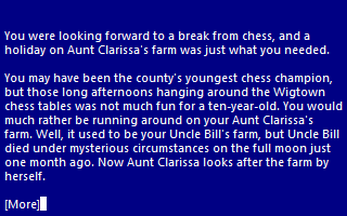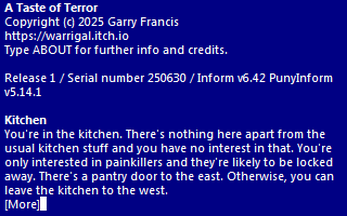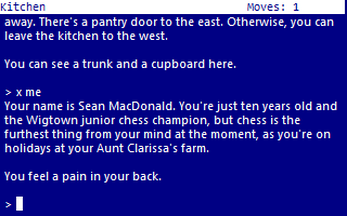
A Taste of Terror
Introduction
You were looking forward to a break from chess, and a holiday on Aunt Clarissa's farm was just what you needed.
You may have been the county's youngest chess champion, but those long afternoons hanging around the Wigtown chess tables was not much fun for a ten-year-old. You would much rather be running around on your Aunt Clarissa's farm. Well, it used to be your Uncle Bill's farm, but Uncle Bill died under mysterious circumstances on the full moon just one month ago. Now Aunt Clarissa looks after the farm by herself.
The train's whistle breaks you out of your reverie. As the brakes squeal, you quickly gather your backpack and get ready to alight at Forfar Station. Your Aunt Clarissa is there to greet you. Her wrinkled hand reaches out and she gives you an icy hug. "How's my little Sean? Welcome back to Forfar!"
Your aunt seems to have aged incredibly since you last saw her at Uncle Bill's funeral. She just doesn't look her normal sprightly self. Her voice is raspy, her skin looks more flabby than usual and she seems to have grown a hooked nose. Uncle Bill's death must have hit her hard, poor thing.
After a short taxi ride through the Sidlaw Hills, you soon reach the farm.
The following day, you go wild jumping in the barn, running through the fields and exploring the hills. Chess is soon a distant memory. Everything is perfect, yet something bothers you about Aunt Clarissa.
When you go to bed that night, you can't get to sleep due to a pain in your back. You guess you must have torn a muscle or something with all the running around, so you tip-toe down to the kitchen to see if you can find a painkiller...
Instructions
This is a traditional text adventure. A text adventure is a form of computer game that presents you with a story. You take on the role of the main character in the story and control that character's actions. The story has a goal and you will need to solve puzzles in order to achieve that goal. The computer tells you where you are, what you can see and what's happening around you. You can then move around, examine the things you find and manipulate those things by telling the computer what to do using simple English commands.
Commands consist of a verb phrase, optionally followed by a noun phrase. Most commands can be abbreviated to a verb followed by a noun. For example, GET THE CLAY JUG can be abbreviated to GET JUG.
If the verb is followed by a preposition, this may alter its meaning. For example, GET LADDER will attempt to pick up the ladder, but GET ON LADDER will attempt to climb onto it.
In some cases, the verb phrase and first noun phrase may be followed by a second noun phrase. The two noun phrases are usually separated by a preposition. For example, HIT MAN will attempt to hit the man with your hands (as you didn't specify a second noun phrase), but HIT MAN WITH CLUB will attempt to hit the man with the club. If you only use a verb and a noun, the game will generally tell you if it needs an extra phrase or implicitly try to deduce what is needed for the second phrase.
Don't panic! It's not as complicated as it sounds. Just use simple English sentences starting with a verb and it will all feel quite natural.
Movement
To move around, use commands like GO NORTH and GO SOUTH. You can move in any of the four cardinal compass directions and four diagonal compass directions, as well as UP and DOWN. To save typing, movement commands can be abbreviated to N, S, E, W, NE, NW, SE, SW, U and D. You can sometimes use other movement commands such as IN, OUT, ENTER, EXIT or CLIMB. These will be reasonably obvious when the time comes.
Examining things
Make sure you EXAMINE everything you come across, even insignificant things like scenery and objects mentioned in room descriptions, as subtle hints and clues are scattered everywhere. To save typing, EXAMINE can be abbreviated to X. For example, EXAMINE WINDOW can be abbreviated to X WINDOW.
Some objects may initially be hidden. You can LOOK IN containers, LOOK ON surfaces and LOOK THROUGH windows, but EXAMINE will usually provide the same information. You can also LOOK UNDER some things.
You may like to try your other senses when it seems appropriate, e.g. SMELL, TOUCH or LISTEN. Unlike EXAMINE, these actions aren't necessary to solve any puzzles.
Manipulating objects
Apart from examining things, most of your time will be spent manipulating objects. Use commands like GET or TAKE to pick up an object, e.g. GET JUG. Use commands like DROP or DISCARD to drop an object, e.g. DROP JUG. Use WEAR to wear something, e.g. WEAR SNEAKERS. Use REMOVE to remove something that is already worn, e.g. REMOVE SNEAKERS.
To see what you're currently carrying and wearing, use INVENTORY (or I). As you're not a pack horse, you can only carry ten items at a time, plus whatever you're wearing. However, there is a container (if you can find it) and you can put any excess items in that container. In fact, the game will try to automatically put something in that container if your inventory is full.
There are many other verbs that can be used to manipulate objects. These will be fairly obvious when the time comes. Common verbs include OPEN, CLOSE, LOCK, UNLOCK, LIGHT, EXTINGUISH, EAT, READ and so on. Use PUT, PLACE or INSERT to put objects into containers or on supporters, e.g. PUT SNEAKERS ON BED.
When dealing with liquids, you can pour a liquid from a container into or onto another object, e.g. POUR WATER ONTO GARDEN and the bucket is implied. Alternatively, you can empty the liquid from the container onto another object, e.g. EMPTY BUCKET ONTO GARDEN and the water is implied. Similarly, you can fill a container with a liquid, e.g. FILL BUCKET WITH WATER, TAKE WATER WITH BUCKET or PUT WATER IN BUCKET.
Communicating with characters
You will encounter a few non-player characters in this game, not necessarily human. When you first meet new characters, in addition to examining them, you should try talking to them if they're human, e.g. TALK TO MAN. To get further information from them, try asking them about something relevant, e.g. ASK WOMAN ABOUT AUNT. If there is only one character present, then you can abbreviate this, e.g. ASK ABOUT AUNT. You will need to ask one character, in particular, about a lot of things to work out what's going on.
You can also try giving things to characters if it seems appropriate, e.g. GIVE KEY TO MAN.
Advanced features
You can use IT or THEM to refer to the noun used in the previous command, e.g. EXAMINE CUPBOARD, OPEN IT (for a singular object) or EXAMINE BOOKS, READ THEM (for plural objects). You can also use HIM and HER to refer to male and female characters used in the previous command, e.g. EXAMINE MAN, TALK TO HIM or EXAMINE WOMAN, ASK HER ABOUT MAN.
You can refer to multiple objects by separating the objects with AND, e.g. GET JUG AND DAGGER. Using IT and THEM in the next command will only refer to the last of those objects, e.g. EXAMINE IT will refer to the dagger.
You can use ALL to refer to all the appropriate objects with GET and DROP, e.g. GET ALL to get everything in the current location, GET ALL FROM CUPBOARD to get everything in the cupboard, DROP ALL to drop everything you're holding.
When using ALL, you can use EXCEPT or BUT to exclude some objects, e.g. DROP ALL EXCEPT THE RUSTY KEY.
Finally, you can enter multiple commands on the same line by separating them with a period, e.g. EXAMINE CUPBOARD. OPEN IT.
Scoring
There is no score in this game. Your objective is to...well, that's for you to find out.
Other commands
Use LOOK (or L) to refresh the display.
Use VERSION to get the game version. Use ABOUT or INFO to get background information and credits for the game. Use CREDITS to get the credits only.
Use SAVE to save your progress. Use RESTORE to restore a saved game.
Use UNDO to undo the last move. This is handy if you change your mind or make a mistake. You shouldn't be able to get into an unwinnable situation in this game, but it is possible to get killed, so save the game when it looks like you're about to get into a dangerous situation.
Use AGAIN (or G) to repeat the last command.
Use WAIT (or Z) to do nothing apart from pass the time.
Use HELP to get a brief reminder of how to play the game or HINT to get a context-sensitive hint related to your current location or current situation.
Use RESTART to restart the game from the beginning. Use QUIT (or Q) to quit without restarting. (Don't use QUIT with the online version of the game, as the game will appear to be locked up. In this case, press the Back button in your browser.)
Most importantly, have fun and enjoy the game.
Keyboard shortcuts
Some interpreters have keyboard shortcuts. If you are using an interpreter on a computer with a conventional keyboard, most will allow you to press the up and down arrow keys to cycle through your past commands. This is handy if you want to repeat the previous command or correct a typo.
Playing the game
There are two ways to play the game.
Click the Run game button (above) to play the game in a browser.
Download the z5 file and play the game using a z-code interpreter (see below).
Finding a z-code interpreter
There are a variety of z-code interpreters for all the major platforms, as well as many minor and retro platforms. There are far too many to list here. See IFWiki for a list of the most common interpreters.
The best source of downloads is probably the Interactive Fiction Archive. Navigate to infocom/interpreters for z-code interpreters and interpreters-multi for interpreters that interpret both z-code games and other formats.
Common z-code interpreters
Android: I recommend Hunky Punk from Google Play or Fabularium from F-Droid.
iOS: I recommend Frotz from the Apple App Store.
Linux: See the links above.
Mac: See the links above.
Windows: I recommend Windows Frotz from the infocom/interpreters link above. (There are others, as well.)
Credits
Inform 6 compiler, language and library originally written by Graham Nelson and now maintained by David Griffith, David Kinder, Andrew Plotkin et al.
PunyInform library written by Johan Berntsson and Fredrik Ramsberg based on the Inform 6 library.
ZAbbrev written by Henrik Åsman.
Parchment interpreter written by Dannii Willis et al.
Concept by unknown author.
Game design and coding by Garry Francis.
Testing by AM Ruf, Charles Moore Jr, Dark Star, Dave Hall, Gianluca Girelli, Jade J Aincioa, Melendwyr and Robert Eggleston.
Background photo in cover image by Luke van Zyl, downloaded from unsplash.
Witch in cover image by razbd07, downloaded from vecteezy.
| Published | 22 days ago |
| Status | Released |
| Platforms | HTML5, Windows, macOS, Linux, Android |
| Author | Garry Francis |
| Genre | Interactive Fiction |
| Tags | Horror, inform-6, punyinform, Retro, text-adventure, Text based, witch, witchcraft |
| Average session | A few hours |
| Languages | English |
| Inputs | Keyboard |




Leave a comment
Log in with itch.io to leave a comment.